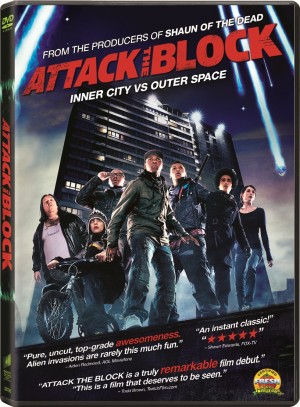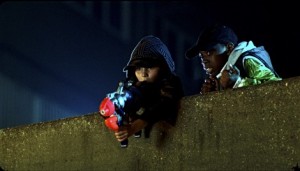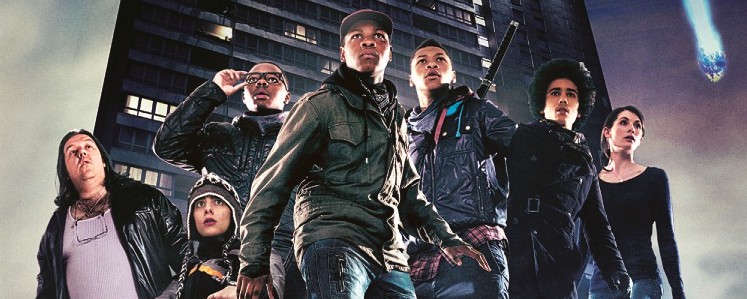Interview with Joe Cornish of ‘Attack the Block’

NEW YORK — Joe Cornish is quickly become a sought after name in Hollywood. In 2011, he not only co-wrote Steven Spielberg’s The Adventures of Tintin, but also released his inaugural directorial effort: Attack the Block (read our review), an extraterrestrial smorgasbord that features nasty aliens, scheming teenagers and one crazy apartment building.
At the New York Comic Con, Cornish talked with several journalists about his experiences making Attack the Block. Here’s an excerpt from that interview.
Did you have any idea that the movie could be a success in America?
Well, anybody who makes a film always dreams that it might be a success. You don’t go into an endeavor as elaborate as making a film without some little voice in your head, ‘Oh man, this could be fucking great.’ But then it’s usually drowned out by the other voices that are going, ‘You’re wasting your time. This is going to be a disaster.’
So, yeah, I always fantasized that it might be, but man it’s extraordinary to be here and to be around the States with it. You know I know Edgar (White) very well, and I trailed around with him during the Hot Fuzz promotional tour. And now I’m visiting all those places myself with my own film. So, yeah, it’s amazingly rewarding, and I feel very appreciative that people dig it.
But it is massively influenced by American cinema, as you know. I was bottle-fed by American cinema. I guess it’s not totally far out that it connects, because we all love similar things, I think.

Why make Attack the Block as your first film?
I was waiting for the right idea. I didn’t want to do something talky. I didn’t want to do a coming-of-age movie. I didn’t want to do something set in one room about people shooting each other, or something.
I was very inspired by the first films by my favorite directors. By Duel, by the first Terminator, I know that wasn’t Cameron’s first. But we’ll sweep to the side Piranhas 2. … By those directors who were trying to make big movies even when they couldn’t. There was a sense of ambition in those films, and those directors forced themselves to deal with the currency of big movies. Action and movement and forward motion and big ideas. I love movies where necessity is the mother of invention. I love the image of Gale Anne Hurd and James Cameron in her garage doing the final shot of the Terminator’s eye.
Now, Terminator 1 is as good, if not better, than hundreds of $150 million movies I could name. But yet it’s basically an independent, low-budget movie. I miss that. I kind of miss that.
I mean lots of filmmakers try to do a similar thing. But I was waiting for an idea that felt like a mini blockbuster.
The creatures in Attack the Block. Where did that idea come from?
It came from lots of different places. It came from looking at my cat. I have a black cat. I’ve grown up with a black cat, and I was fascinated by how when you backlight a black-furred animal it looks two-dimensional. It looks like a shadow. It occurred to me that film is the process of capturing a three-dimensional space and flattening it.
So I thought, almost mathematically, What if you had a creature that was so black that its fur absorbed light? And it visually looked like my cat. Wouldn’t that sit in a film image in a cool way? And it reminded of Ralph Bakshi’s Lord of the Rings where he used rotoscope. It reminded me of Pete’s Dragon. It reminded me of Mary Poppins. It reminded me of contemporary performance capture techniques where you’re almost painting over live action. You know the techniques they used in Snow White, or the first SNES game to use performance capture called Another World.
And I just thought … cool that might work. We tested it six months before we shot, and it kind of worked.
By that time, I had a sense of the overall look of the film. It was all at night, and I was going to be dealing with high contrast bright colors and deep, deep shadows. And I thought, OK, if the body is a deep shadow, there should be a secondary point to draw your attention.
I was looking at a back issue of Cinefex, and I was reading about how Spielberg and (Carlo) Rambaldi put a light in E.T.’s chest and finger, and how much Spielberg uses light to express emotion, in Close Encounters and E.T. And that gave me the idea to make the teeth glow. That was that. We approached the design of the movie and the cinematography and the post production all with that in mind, with making the creature work.
We did a special grade for the DVD and Blu-ray to make sure the black tones work. I used to obsessively watch DVDs and look at the black tones.
Do you have a name for the aliens?
Just big gorilla wolf motherfuckers. It’s not catchy, but it’s descriptive.
The dialect is very unique and very British. Was it hard to write like that?
We did a lot of research. I spoke to hundreds of young people. I started with a treatment, and before I wrote the script, I went to loads of young people and talked through the story and listened to what they said. So a lot of the lines in the film are things people said to me.
‘Too much madness for one text.’
‘Better off calling the Ghostbusters.’
‘I don’t want to get chlamydia.’
Teenagers are funny, and they know they’re funny. They’re naturally funny, and that’s hopefully where the comedy of the film comes from. It’s not goofy or gaggy. It’s just teenagers being teenagers. Sometimes intentionally, sometimes unintentionally.
By John Soltes / Publisher / John@HollywoodSoapbox.com

